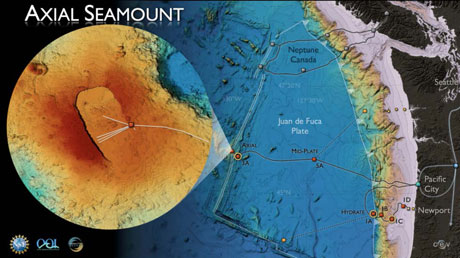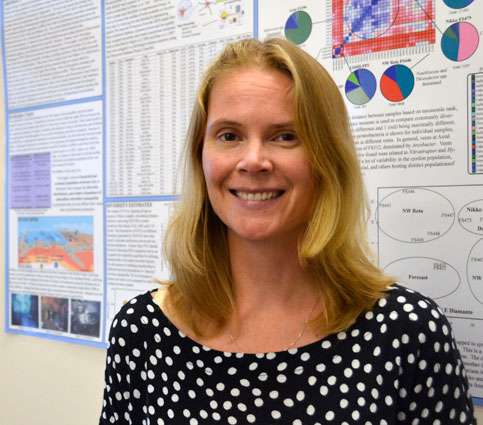MBL’s Julie Huber to Lead Research Expedition to Deep-Sea Volcano

Contact: Gina Hebert
508-289-7725, ghebert@mbl.edu
Woods Hole, MA –MBL (Marine Biological Laboratory) microbial oceanographer Julie Huber will lead a national team of scientists on a deep-sea expedition to Axial Seamount, an active volcano 300 miles off the Oregon coast. The researchers are seeking to better understand the vast diversity of marine microbial communities that dominate the oceans and how they mediate the cycles, particularly the carbon cycle, that shape Earth’s habitability.
Working aboard the research vessel R/V Falkor, operated by Schmidt Ocean Institute, Huber and her colleagues will study how the viral and microbial communities that live in the rocky outer layer of the mile-deep submarine volcano interact and alter the flow of carbon and other nutrients in the subseafloor crustal ecosystem.
 Location of Axial Seamount and its Regional Scale Node (RSN), part of the Ocean Observatories Initiative’s cabled observatory network. Image credit: Regional Scale Nodes, University of Washington.
Location of Axial Seamount and its Regional Scale Node (RSN), part of the Ocean Observatories Initiative’s cabled observatory network. Image credit: Regional Scale Nodes, University of Washington.Unlike most of the ocean, the subseafloor environment does not directly receive organic matter derived from photosynthesis. As such, the potential for new carbon production within the subseafloor is rarely considered in traditional oceanographic paradigms of carbon cycling or microbial food webs due to how little is known about this underexplored and potentially ubiquitous microbial habitat.
“We want to work out the carbon budget in this ecosystem and get a quantitative model of carbon going in and out,” says Huber. “The functional consequences of an extensive population of microbes living in the subseafloor remains unknown, as does our understanding of how these organisms interact with one another and influence the biogeochemistry of the oceans.”
Huber and her team will also be focusing on viruses. “Viruses are understudied in the deep sea and need to be considered when we think about carbon because viral infection of microbial cells results in cells lysing [breaking open], thus releasing carbon and other nutrients back into the subseafloor and deep sea.”
During the cruise the team will use a remotely operated underwater vehicle (ROV) to conduct interactive experiments and collect fluid samples from the seafloor. The samples will then be brought onboard for incubation experiments and comparison to laboratory experiments. “We are developing instruments to do experiments on the seafloor,” says Huber. “And the experiments we will do aboard the R/V Falkor will inform the decisions on how exactly we design that instrumentation and carry out experiments on the seafloor. We want to find out if the experiments we do in the lab really reflect what is happening on the seafloor.”
Huber’s sea time on the Falkor is financed by Schmidt Ocean Institute, founded by Eric Schmidt, the executive chairman of Google, and his wife Wendy. Her research project is funded by the Gordon and Betty Moore Foundation through grant GBMF3297.
The expedition will take place from September 22 - October 4, 2013. In addition to Huber, the research team includes scientists from the University of Washington, NOAA Pacific Marine Environmental Laboratory, University of Massachusetts, Amherst, and J. Craig Venter Institute.
The ship will be providing live video feed from the seafloor during ROV dives starting September 24. There will be additional information and regular blog posts/photos at: http://www.schmidtocean.org/story/show/2038. The team will be tweeting #SubseafloorLife with Huber posting from @JulesDeep and the Schmidt Ocean Institute from @SchmidtOcean.

About Julie Huber
Huber is an Associate Scientist in the Josephine Bay Paul Center for Comparative Molecular Biology and Evolution where she joined the staff in 2007. Her research investigates microbial communities at deep-sea hydrothermal vents and within the subseafloor, a largely undiscovered environment that represents a unique and ubiquitous habitat on Earth. As part of the Brown-MBL Graduate Program in Biological and Environmental Sciences, Huber is an assistant professor in the Department of Ecology and Evolutionary Biology at Brown University. Huber has logged over a year at sea exploring the deep ocean. Due to the challenges of understanding this habitat, she employs a combination of molecular, cultivation, and geochemical approaches to understand the microbial populations and their local adaptations to the crustal environment.
—###—
The Marine Biological Laboratory (MBL) is dedicated to scientific discovery and improving the human condition through research and education in biology, biomedicine, and environmental science. Founded in Woods Hole, Massachusetts, in 1888, the MBL is a private, nonprofit institution and an affiliate of the University of Chicago. Schmidt Ocean Institute is dedicated to the support of oceanographic research that expands understanding of the world’s ocean through technological advancements, intelligent observation and analysis, and open information sharing. Research collaborators are chosen through a rigorous peer review process.
The Gordon and Betty Moore Foundation believes in bold ideas that create enduring impact in the areas of science, environmental conservation and patient care. Intel co-founder Gordon and his wife Betty established the foundation to create positive change around the world and at home in the San Francisco Bay Area. Science looks for opportunities to transform–or even create–entire fields by investing in early-stage research, emerging fields and top research scientists. Our environmental conservation efforts promote sustainability, protect critical ecological systems and align conservation needs with human development. Patient care focuses on eliminating preventable harms and unnecessary healthcare costs through meaningful engagement of patients and their families in a supportive, redesigned healthcare system. Visit us at Moore.org or follow @MooreScientific.